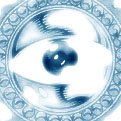The Mandragora officinarum, is a plant called by the Arabs luffâh, or beid el-jinn ("djinn's eggs"). The parsley-shaped root is often branched. This root gives off at the surface of the ground a rosette of ovate-oblong to ovate, wrinkled, crisp, sinuate-dentate to entire leaves, 6 to 16 inches long, somewhat resembling those of the tobacco-plant. There spring from the neck a number of one-flowered nodding peduncles, bearing whitish-green flowers, nearly 2 inches broad, which produce globular, succulent, orange to red berries, resembling small tomatoes, which ripen in late spring. They are succeeded by a smooth, round fruit, about as large as a small apple, of a deep yellow colour when ripe, full of pulp and with a strong, apple-like scent. All parts of the mandrake plant are poisonous.

Over the ages, the mandrake has been endowed with a wonderful and mystical aura. Examples are superstitions regarding harvesting of the plant. While being torn from the ground, the mandrake would emit a horrible shriek that would be fatal to the unprotected harvester who hears it. So, if someone simply pulled the plant, they would either die, deafen, go mad. The occult literature includes complex directions for harvesting a mandrake root in relative safety; to avoid a horrible fate, the plant could be partially dug with a few remaining roots staying in the ground.
Then a starved black dog was tied to the mandrake with a rope. The harvester, with plugged ears, would throw some scraps to the hungry dog. When the unsuspecting animal lunged for food, the mandrake would be completely unrooted and the ensuing shriek would kill the dog and spare the man.
According to different legends quoted by Theophrastus and Pliny the Elder, other dire consequences of unrooting a mandrake could be avoided by making circles around the plant on the ground with a sword and then facing west while digging. If there were a true Anaesthetic of Antiquity it would have been mandragora. Dioscorides describes how the wine made from mandragora produces anaesthesia: Using a cyathus of it on those who cannot sleep, or are grievously pained, or are being cut, or cauterized they will not feel pain. Here Dioscorides used for the first time the word anaesthesia as absence of sensation as we mean it today.

It was a common belief in some countries that a mandrake would grow where the semen of a hanged man dripped on to the earth; this would appear to be the reason for the methods employed by the alchemists who "projected human seed into animal earth". It was said that mandrake increased fertility in women, but this is an under-studied subject.
Mandrake was much used by the Ancients, who considered it an anodyne and soporific. In large doses it is said to excite delirium and madness. They used it for procuring rest and sleep in continued pain, also in melancholy, convulsions, rheumatic pains and scrofulous tumours. They mostly employed the bark of the root, either expressing the juice or infusing it in wine or water. The root finely scraped into a pulp and mixed with brandy was said to be efficacious in chronic rheumatism.
In Genesis: 30, Reuben, the eldest son of Jacob and Leah finds mandrakes in the field. Rachel, Jacob's second wife, the sister of Leah, is desirous of the mandrakes and she barters with her sister for them. The trade offered by Rachel is for Leah to spend the next night in Jacob's bed. Soon after this Rachel, who was previously barren, gives birth to a son, Joseph. There are classical Jewish commentaries who suggest that mandrakes help barren women to conceive a child. Mandrake in Hebrew is דודאים, meaning “love plant”. It was believed by Asian cultures to ensure conception...
Sources: Various


No comments:
Post a Comment